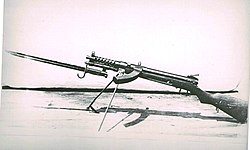Submachine gun

A submachine gun is a type of gun that shoots many bullets, usually pistol bullets, when one holds down the trigger. A submachine gun is smaller than a machine gun and can easily be carried by one person. They are often used where people need to defend themselves in small areas, or people need to fire many bullets quickly. The first submachine guns were invented in the early 1900s. They are often used by the police and counter-terrorism units .[1]
History
In the early 20th century, experiments were made by converting pistols from semi to fully automatic firearms. Automatic weapons with gunstock and firing pistol rounds were developed around the same time during World War I, by Italy, Germany, and the United States. The first dedicated designs were developed in the latter stages of World War I both as improvements on earlier stocked pistols, and to offer an advantage in trench warfare.
They were popularized in the 1920s and '30s as weapon of choice of American gangsters and police, in the form of the famous Thompson submachine gun, commonly referred to as the "Tommy Gun". Submachine guns rose to prominence as a frontline close-quarters combat weapon and commando firearm during World War II. They are now widely used by police[2] SWAT, military commando, paramilitary, and counter-terror team members for a variety of situations.
Submachine guns are highly effective in close quarters; their lower-powered pistol cartridges make them generally more controllable in fully-automatic fire compared to assault rifles, while their small size and light weight grant maneuverability. However, pistol bullets often are stopped by body armor or cover, and are short-ranged compared to intermediate and rifle cartridges.
World War II developments
World War II developments were many and interesting. In Germany the development of machine carbines (Maschinenkarabiner) was notable. From 1939 onwards the German Army analyzed combat conditions and developed new tactics and equipment requirements.[3] The existing 7.92x57mm rifle cartridge was more powerful and long ranged than needed. Most combat took place at ranges less than 400 m (440 yards). A less powerful round (bullet) could be used. This meant a soldier could carry more ammunition, the weapon could be shorter, lighter and with less recoil. The gun could be an automatic.
Achieving this took time. Work in 1941 and 1942 led at last to a reliable weapon, the StG 44 (Sturmgewehr 44) "assault rifle 44". This was then produced in large numbers (over 600,000). It came too late to effect the Second World War, but was later adapted as the Soviet AK 47.
Submachine Gun Media
A Mini Uzi and a Heckler & Koch MP5K, two common submachine guns
Artillery Luger P08 pistol with snail-drum magazine and removable stock.
A Standschütze Hellriegel M1915, the first submachine gun with a buttstock, seen here with stick and drum magazines
General John T. Thompson holding a Thompson Model 1921
References
- ↑ "Problems of the sub-machine gun". saf.org. Archived from the original on 21 August 2010. Retrieved 22 July 2010.
- ↑ "saf.org". Archived from the original on 2010-08-21. Retrieved 2010-07-22.
- ↑ Chamberlain, Peter (1976). Sub-machine guns and automatic rifles. Gander, Terry. New York: Arco Pub. Co. p. 23. ISBN 0668040130.
Other websites
- WW2-era Small Arms
- Submachine gun -Citizendium









